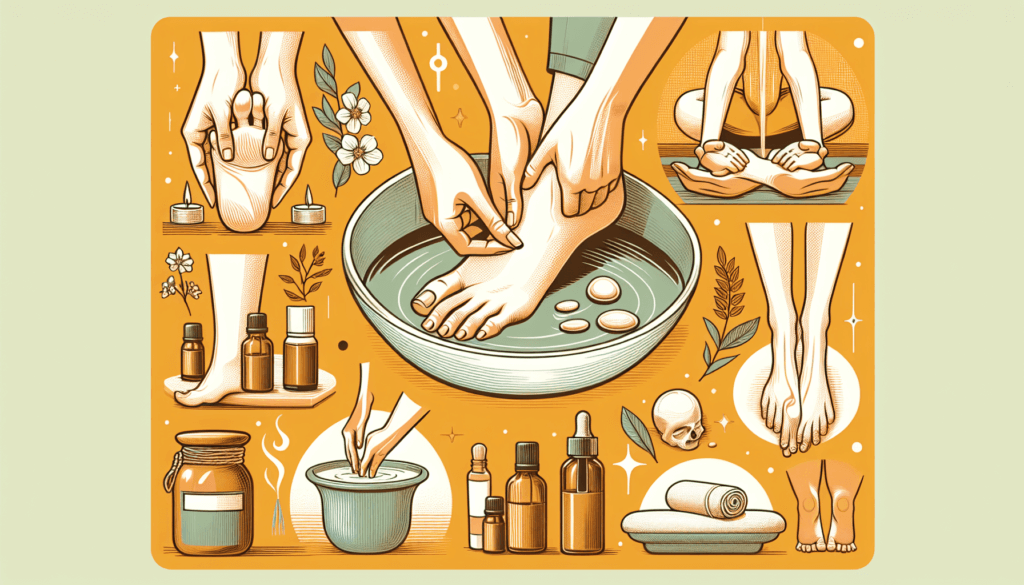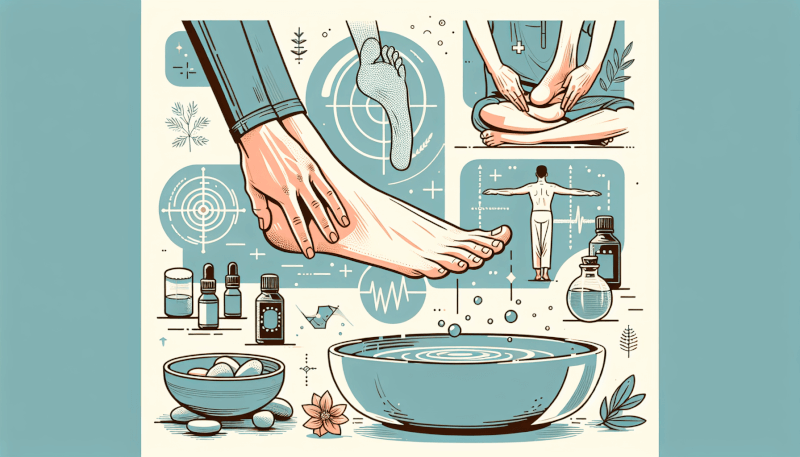Hey there! Are your tired, achy feet causing you discomfort? Look no further! In this article, we’ll explore some effective and natural remedies to alleviate foot pain. Whether you spend long hours on your feet or have chronic foot issues, we’ve got you covered. Discover simple yet powerful solutions that can help soothe inflammation, ease muscle tension, and promote overall foot health. Say goodbye to foot pain and hello to happy, healthy feet in no time!

Stretching exercises
Calf stretches
Calf stretches are a great way to relieve foot pain and tension. To perform a calf stretch, stand facing a wall and place your hands on the wall for support. Take a step back with one foot and keep it straight, while bending the other knee and leaning forward. You should feel a stretch in your calf muscle. Hold the stretch for 30 seconds and repeat on the other side.
Toe stretches
Toe stretches can help to alleviate foot pain and increase flexibility in the toes. To perform toe stretches, sit on a chair and place your foot on the opposite knee. Grab your toes with your hand and gently pull them back, feeling a stretch in the top of your foot. Hold the stretch for 15-30 seconds and repeat on the other foot.
Achilles stretches
The Achilles tendon can often become tight and lead to foot pain. To stretch the Achilles tendon, stand facing a wall and place your hands on the wall for support. Step one foot back and keep it straight, while bending the front knee. Lean forward, feeling a stretch in the back of your calf and Achilles tendon. Hold the stretch for 30 seconds and repeat on the other side.
Foot massages
Self-massage with a tennis ball
A tennis ball can be a simple and effective tool for massaging the feet. Sit on a chair and place a tennis ball on the floor. Roll your foot over the ball, applying gentle pressure and targeting areas of tension or discomfort. Spend a few minutes massaging each foot to relieve foot pain and promote relaxation.
Rolling a frozen water bottle
Using a frozen water bottle to massage the feet can provide relief by reducing inflammation and numbing pain. Place a water bottle in the freezer until it becomes frozen. Sit on a chair and roll the frozen bottle under your foot, focusing on the areas that feel sore or tender. The cold sensation can help to alleviate foot pain and reduce swelling.
Using a foot roller
A foot roller is a specialized tool designed to massage the feet and promote foot health. Simply place the foot on the roller and roll it back and forth, applying pressure as needed. This can help to relieve tension in the muscles and fascia of the feet, reducing foot pain and improving overall foot function.
Epsom salt soak
Preparing an Epsom salt bath
Epsom salt, also known as magnesium sulfate, is a popular remedy for foot pain and relaxation. To prepare an Epsom salt bath, fill a basin or tub with warm water and add a half cup to a cup of Epsom salt. Stir the salt until it dissolves completely in the water.
Soaking the feet for relaxation
Once the Epsom salt has dissolved, soak your feet in the warm saltwater solution for 15-20 minutes. This can help to relax the muscles and relieve foot pain. You can also add a few drops of essential oil, such as lavender or peppermint, for an extra soothing effect.
Potential benefits of Epsom salt
Epsom salt contains magnesium, which can help to reduce inflammation and soothe sore muscles. It may also improve blood circulation and promote relaxation. Regular Epsom salt soaks can be a beneficial natural remedy for foot pain and overall foot health.
Ice therapy
Applying an ice pack
Ice therapy can be an effective way to reduce foot pain and inflammation. Fill a plastic bag with ice cubes or use a store-bought ice pack. Place the ice pack on the area of the foot that is experiencing pain, such as the heel or arch. Leave the ice pack on for 10-15 minutes, ensuring that you have a layer of fabric between the pack and your skin to prevent ice burn.
Cold water soak
If you don’t have an ice pack, you can also use a cold water soak for ice therapy. Fill a basin or tub with cold water and add some ice cubes. Submerge your foot in the cold water for 10-15 minutes, allowing the cold temperature to reduce inflammation and numb the pain.
Benefits and precautions
Ice therapy can help to reduce swelling, numb pain, and provide temporary relief for foot pain caused by conditions such as plantar fasciitis or tendonitis. However, it is important to use caution and not apply ice directly to the skin to prevent ice burn. Additionally, individuals with certain circulatory conditions or sensitivities to cold should consult a healthcare professional before using ice therapy.

Foot elevation
Using pillows or foam blocks
Elevating your feet can promote blood circulation and reduce swelling, providing relief from foot pain. To elevate your feet, lie down on a bed or couch and prop your feet up on pillows or foam blocks. Make sure that your feet are elevated above your heart level for optimal results.
Reducing swelling and improving circulation
By elevating your feet, you can help to reduce swelling and improve blood circulation. This can be particularly beneficial for individuals with conditions such as edema or plantar fasciitis, where foot pain and swelling are common symptoms. Elevating the feet regularly throughout the day can provide ongoing relief and support healing.
Essential oils
Lavender oil for relaxation
Lavender oil is well-known for its calming and relaxing properties. To use lavender oil for foot pain, add a few drops to a carrier oil, such as coconut oil or almond oil, and massage it into the feet. The soothing aroma and the gentle massage can help to alleviate foot pain and promote relaxation.
Peppermint oil for pain relief
Peppermint oil has analgesic and anti-inflammatory properties, making it an excellent choice for relieving foot pain. Mix a few drops of peppermint oil with a carrier oil and massage it into the affected area. The cooling sensation of peppermint oil can provide immediate relief and help reduce inflammation.
Rosemary oil for inflammation
Rosemary oil has anti-inflammatory properties that can help to reduce pain and inflammation in the feet. Mix a few drops of rosemary oil with a carrier oil and massage it into the feet. The soothing properties of rosemary oil can provide relief from foot pain and promote overall foot health.
Hot and cold water therapy
Alternating hot and cold water soaks
Alternating hot and cold water soaks can help to improve blood circulation and reduce inflammation in the feet. Start by soaking your feet in warm water for 3-5 minutes, and then switch to cold water for 1-2 minutes. Repeat this process three times, ending with a cold water soak. This contrast therapy can provide relief from foot pain and promote healing.
Enhancing blood flow and reducing inflammation
Hot water soothes and relaxes the muscles, while cold water constricts the blood vessels, reducing inflammation. The contrast between hot and cold can promote blood flow and help to alleviate foot pain caused by conditions such as arthritis or gout. It is important to gradually increase the temperature of the water to avoid burns.
Foot exercises
Toe curls
Toe curls are a simple exercise that can help to strengthen the muscles in the feet and relieve foot pain. Sit on a chair and place a small towel or cloth on the floor in front of you. Place your foot on the towel and use your toes to grip and curl the fabric towards you. Release and repeat the exercise 10-15 times on each foot.
Ankle rotations
Ankle rotations can improve flexibility and mobility in the ankles, reducing foot pain and discomfort. Sit on a chair and extend one leg in front of you. Rotate your ankle clockwise for 10-15 rotations and then switch to counterclockwise rotations. Repeat the exercise on the other foot.
Resistance band exercises
Using a resistance band can help to strengthen the muscles in the feet and improve foot stability. Sit on a chair and place a resistance band around your foot, holding the ends with your hands. Flex your foot and push against the resistance of the band, stretching it. Release and repeat the exercise 10-15 times on each foot.
Footwear modifications
Choosing supportive shoes
Wearing supportive shoes is essential for foot health and preventing foot pain. When choosing shoes, look for ones that provide adequate arch support, cushioning, and a wide toe box. Avoid shoes that are too tight or have high heels, as they can lead to foot pain and discomfort.
Using orthotic inserts
Orthotic inserts can provide additional support and cushioning to address specific foot issues and alleviate foot pain. Consult with a podiatrist or foot specialist to determine the best type of orthotic inserts for your needs. Inserts can be placed in your shoes and provide extra comfort and support throughout the day.
Avoiding high heels and tight shoes
High heels and tight shoes can cause foot pain and discomfort by placing excessive pressure on the feet and altering the natural alignment. Avoid wearing high heels regularly, and opt for shoes that have enough room for your toes to move freely. Choosing comfortable and properly fitting shoes can prevent foot pain and promote foot health.
Rest and relaxation
Taking regular breaks
Resting your feet and taking regular breaks throughout the day can help to prevent and alleviate foot pain. If you have a job that requires prolonged standing or walking, try to take short breaks to sit down and elevate your feet. This can reduce fatigue and provide relief for tired and achy feet.
Using footrests
Using footrests can provide additional support and relieve pressure on the feet when sitting for extended periods. Place a footrest under your desk or use a small stool to elevate your feet. This can help to improve blood circulation and reduce foot pain caused by prolonged sitting.
Allowing time for healing
Giving your feet time to heal and recover is essential for foot pain management. If you have been experiencing foot pain, try to avoid activities that exacerbate the pain and allow your feet to rest. This can include avoiding high-impact activities, wearing supportive shoes, and engaging in foot relaxation techniques. By prioritizing rest and relaxation, you can support the healing process and prevent further foot pain.


